Balochi needlework
Balochi needlework (also known as Balochi embroidery; Balochi: گُد دۏچی) is a type of handicraft made by the Baloch people.[1] It is considered a heritage art, has been recognized by UNESCO, and it sells internationally.[1][2]

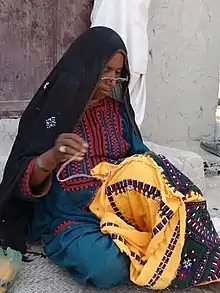 Balochi woman creating needlework in Iran | |
| Type | Handicraft |
|---|---|
History
The Baloch people are from the Pakistani province of Balochistan; the Iranian province of Sistan and Baluchestan; and the southern areas of Afghanistan, including Nimruz, Helmand and Kandahar provinces.[3] The exact history of Balochi needlework is unknown, but one theory is it was brought from the migration of the Slavs to Balochistan approximately 200 years before the founding of Islam,[4] their traditional embroidery is called Rushnyk and contains many similarities. Another theory is the craft had developed alongside the silk production industry.[5]
Different regions of Balochi tribes have their own distinct needlework designs.[6] This craft has traditionally been created only by women, and has been passed down through the generations.[4][7][6] The stitching designs and patterning hold meaning; common motifs include arrows, "chicken feet", diamonds, and flowers.[6] Some of the designs may also incorporate other materials such as small pieces of mirror (known as shisha), different colors of thread, and/or pieces of colored fabric.[1] The needlework was traditionally used for decorating women's clothing, however it has also been used for decorating pillows, curtains, tablecloths, and men's clothing.[8]
In 2015, the majority of the sales of Balochi needlepoint clothing happened in Pakistan and Afghanistan.[8]
Notable Balochi needlework artisans include Mahtab Norouzi.[9] Farah Diba Pahlavi, the former Shahbanu of Iran, was particularly interested in the Balochi needlework handcrafts and had used it in many of her formal dresses.[10] It has been speculated that Mahtab Nowroozi may have embroidered the Pahlavi dresses.[10]
- Examples of Balochi needlework styles

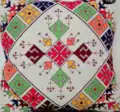
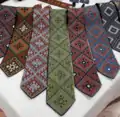
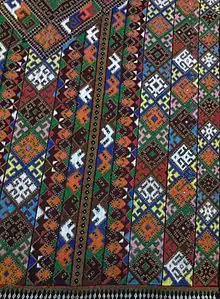

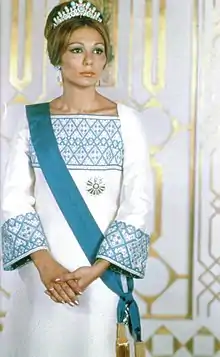
References
- "دریافت مهر اصالت از سازمان جهانی یونسکو، ثبت در میراث معنوی و نشان مرغوبیت ایرانی/ بلوچی دوزی، هنری در بطن زندگی زنان بلوچ". Young Journalist Club (YJC) (in Persian). Retrieved 2022-03-11.
- Kundi, Mansoor Akbar (1993). Balochistan, a Socio-cultural and Political Analysis. Qasim Printers. p. 106.
- Panah, Hamid Yazdan (25 March 2016). "Human Rights in Balochistan: A Case Study in Failure and Invisibility". The Huffington Post. Retrieved March 12, 2022.
- Heidari, Zahra (2016-11-13). "سوزندوزی بلوچ، هنری ریشهدار در تاریخ" [Baloch embroidery, an art rooted in history]. ایسنا (ISNA) (in Persian). Retrieved 2022-03-11.
- Naseh, Zabihullah (1965). Balochistan. Tehran, Iran: Sina.
- Baloch, Shezad (2012-03-24). "Balochi ensembles: The threads of time". The Express Tribune. Retrieved 2022-03-12.
- "بلوچیدوزیِ زنان؛ میراثی رو به اغما" [Balochi embroidery of women; A legacy in a coma]. صاحبخبر (in Persian). 2017-10-03. Retrieved 2022-03-11.
- "پوشش گرانقیمت زنان بلوچ" [Expensive clothing of Baloch women]. ایسنا (ISNA) (in Persian). 2015-04-20. Retrieved 2022-03-12.
- "مهتاب نوروزی، مشهورترین سوزن دوز بلوچ درگذشت" [Mahtab Norouzi, the most famous Baloch needlewoman, has died]. BBC News فارسی (in Persian). 2012-07-15. Retrieved 2022-03-10.
- "مهتاب نوروزی؛ نماد نیم قرن سوزن دوزی در بلوچستان" [Mahtab Norouzi; Symbol of half a century of needlework in Balochistan]. BBC News فارسی (in Persian). 16 July 2012. Retrieved 9 May 2022.
External links
- "The Intricacy and Beauty of Balochi Embroidery". Voice of Balochistan. 2020-06-11. Retrieved 2021-04-04.
- مرضيه, قاسمي; خاتون, محمودي سكينه; سيدرسول, موسوي حاجي (March 12, 2021). "ساختار صوري نقوش طبيعي در سوزن دوزي زنان بلوچ (با تاکيد بر نمونه هاي شهرستان سراوان)" [The formal structure of natural motifs in the needlework of Baloch women (with emphasis on examples from Saravan city)] (in Persian). 8 (27): 60–73.
{{cite journal}}: Cite journal requires|journal=(help)


